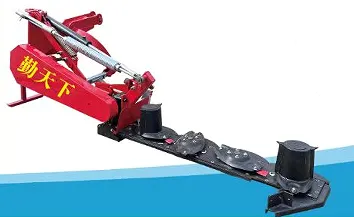Four-Wheel Harvesting Machine for Efficient Crop Collection and Binding Process
The Four-Wheel Reaper Binder A Revolutionary Piece of Agricultural Machinery
Agriculture has witnessed significant transformations throughout history, driven largely by technological innovations aimed at improving efficiency and productivity. Among these advancements, the four-wheel reaper binder stands out as a pivotal invention that revolutionized the way crops are harvested and processed. Combining the functionalities of cutting and bundling in a single machine, this piece of equipment has not only enhanced farming operations but has also shaped the agricultural landscape.
Historical Context
Before the advent of the four-wheel reaper binder, farmers relied heavily on manual labor for harvesting crops. This often meant long hours of backbreaking work, especially during harvest season when time was of the essence. The introduction of simple reaping machines in the 19th century marked the initial shift toward mechanization. However, the breakthrough came with the invention of the reaper binder, which was designed to cut the grain and tie it into neat bundles ready for transport.
The four-wheel version of this machine emerged as a more stable and robust alternative to its predecessors, which typically had two wheels. The design allowed for better balance and distribution of weight, making it easier for farmers to navigate through various terrains, whether muddy fields or gently rolling hills. This increased stability led to greater productivity and, ultimately, a higher yield of harvested crops.
Mechanism of Operation
The four-wheel reaper binder operates through a series of mechanically interlinked components. The front of the machine features a cutting bar with sharp blades that slice through the stalks of grain. As the machine moves forward, the cut grain is drawn into a gathering mechanism that positions it for bundling. The importance of efficiency at this stage cannot be overstated; a well-designed gathering system ensures minimal loss of grain and optimizes the overall harvesting process.
Once the grain is gathered, it is then tied into bundles using twine or wire, thanks to the machine's binding mechanism. This simultaneous operation of cutting and bundling dramatically reduces the time required for harvest compared to manual methods. In many cases, what would take a crew of farmers hours or even days can be accomplished in a matter of minutes with a four-wheel reaper binder.
four wheel reaper binder

Impact on Farming Practices
The introduction of the four-wheel reaper binder had profound implications for farming practices. Firstly, it significantly reduced the labor costs associated with harvesting. Before mechanization, farmers had to rely on seasonal laborers, and finding dependable help was often a challenge. With machinery like the reaper binder, a single operator could accomplish the work that previously required several hands, leading to a dramatic shift in labor dynamics.
Furthermore, the increased efficiency meant that farmers could harvest their crops at optimal times, reducing the risk of loss due to adverse weather conditions. Being able to harvest sooner and faster allowed for better crop management and, consequently, improved profitability. Additionally, the ease of bundling and transporting the grain facilitated logistics, enabling farmers to get their produce to market more quickly.
Modern Evolution and Legacy
Today, the four-wheel reaper binder continues to evolve, influenced by advances in technology such as GPS and automated controls. Modern iterations are often equipped with digital monitoring systems that track performance and yield in real-time. This data-driven approach allows farmers to make informed decisions that can lead to even greater efficiencies.
The legacy of the four-wheel reaper binder is evident not just in its mechanical design but in its impact on agricultural productivity globally. As the world’s population continues to grow, the need for efficient food production becomes ever more critical. Innovations like the four-wheel reaper binder exemplify how technology can help meet these challenges.
Conclusion
In conclusion, the four-wheel reaper binder represents a significant milestone in the history of agriculture. By dramatically improving the harvesting process, this machinery has enhanced productivity, reduced labor costs, and transformed farming practices for generations. As agricultural technology continues to advance, the principles embodied in the design and operation of the four-wheel reaper binder will undoubtedly keep influencing the future of farming. Its place in the narrative of agricultural innovation is assured, symbolizing the balance between tradition and progress in the quest to feed a growing world.
Latest news
-
When to Upgrade Your Old Forage HarvesterNewsJun.05,2025
-
One Forage Harvester for All Your NeedsNewsJun.05,2025
-
Mastering the Grass Reaper MachineNewsJun.05,2025
-
How Small Farms Make Full Use of Wheat ReaperNewsJun.05,2025
-
Harvesting Wheat the Easy Way: Use a Mini Tractor ReaperNewsJun.05,2025
-
Growing Demand for the Mini Tractor Reaper in AsiaNewsJun.05,2025
